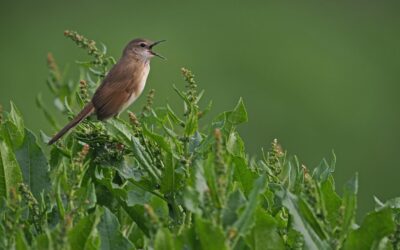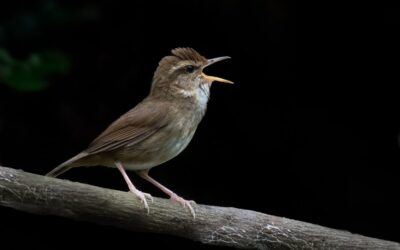Gard W. Otis & Nyaton Kitnya
Gard Otis is a professor at the University of Guelph, Canada. He has conducted research on Asian honey bees for 35 years, but also has a lifelong passion for birds. Nyaton Kitnya is affiliated with Ashoka University, India. She recently obtained her PhD degree studying the Himalayan Giant honey bee. Together, they hope the Yellow-rumped Honeyguide and its association with honey bees to be discovered this year in the Pir Panjal Range of Jammu and Kashmir.
The Yellow-rumped Honeyguide Indicator xanthanotus (Fig. 1), a remarkable species, inhabits river valleys along the southern edge of the Himalaya from southern China to Pakistan (Fig. 2). It has several interesting characteristics, many of which are intimately linked to honey bees. Honeyguides are the only vertebrates known to be able to digest and obtain nutrition from beeswax, which they readily consume. Secondly, all species are believed to be brood parasites that lay their eggs in the nests of other species. The Greater Honeyguide Indicator indicator of sub-Saharan Africa amazingly cooperates with humans by guiding them to colonies of honey bees; the honey collectors consume honey and bee brood, while the bird feeds on beeswax in the combs left behind!
The Yellow-rumped Honeyguide is also associated with honeybees, specifically the Himalayan Giant Honey bee Apis laboriosa. The males feed upon and defend empty combs; when females arrive to eat wax, they are courted and mated by the defending male. A single male may mate with more than a dozen females during the breeding season!
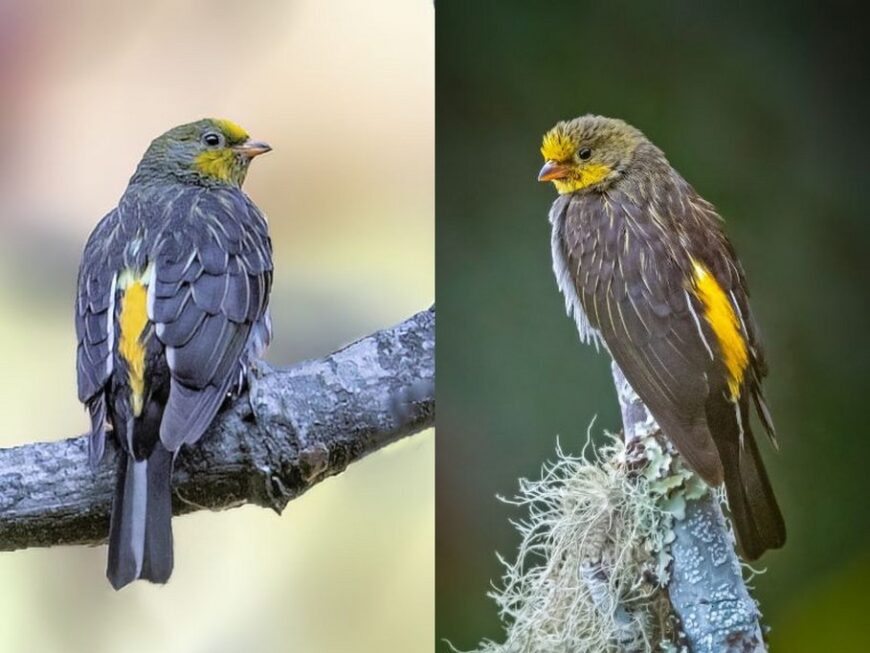
Fig. 1 (left to right): Yellow-rumped Honeyguides Indicator xanthanotus by Parmil Kumar, Sriram Reddy, and ML Library. The individual bird from Uttarakhand (left) displays a greyer appearance compared to the bird from Arunachal Pradesh (right). Honeyguides in the border region between India and Pakistan likely resemble the bird on the left.
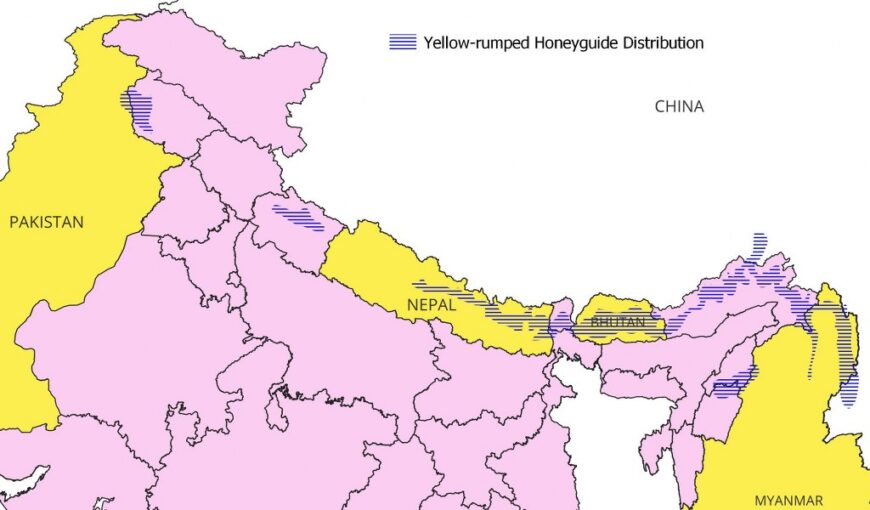
Fig. 2: The Yellow-rumped Honeyguide’s approximate range. Source: BirdLife International, 2024
Historical and Current Status
There are several locations where the Yellow-rumped Honeyguide is regularly observed and photographed (such as Makkumath in Uttarakhand, India; Gandhak and Bagmati in Nepal; Lachen in Sikkim, India; Honey Rock in Bhutan; and Eaglenest WLS in Arunachal Pradesh, India). In contrast, it is very poorly known in the western part of its range (Himachal Pradesh, Jammu and Kashmir). It was reported only once in west of Uttarakhand, 100 years ago by Hugh Whistler at Triund, just north of Dharamshala. It was also observed sporadically between 1867 and 1909 in northwestern Pakistan between Murree and Nathia Galia. Scientists recently observed the birds in the Neelum [=Kishanganga] Valley, Leepa, and Chakothi, in Pakistan-administered Kashmir—all within a few kilometers of the Line of Control (LoC) with India! It almost certainly occurs in high elevation river valleys on the western side of Pir Panjal and other mountain valleys (e.g. Gurez) of Jammu and Kashmir—where it remains to be discovered for the first time.
Tips to Locate The Yellow-rumped Honeyguide
The Yellow-rumped Honeyguide is most frequently encountered at aggregations of colonies of the Himalayan Giant Honey bee Apis laboriosa on rock cliffs. (The honeyguides are not known to visit abandoned combs of the lowland tree-nesting bee species, Giant Honey bee Apis dorsata). The A. laboriosa bees migrate seasonally; after they abscond from their nests, the honeyguides visit the empty combs and eat beeswax. They are also known to eat a variety of insects, some of which they chase in flight, like flycatchers. Occasionally, they have been observed at the entrance of an Asian honey bee Apis cerana colony in a tree or rock cavity. The honeyguides appear to live in harmony with giant honey bees: they never approach active colonies of Apis laboriosa and the bees seem undisturbed by the birds as they feed nearby on the white beeswax of empty nests (see video).
Video of Yellow-rumped Honeyguide feeding on beeswax.
The Yellow-rumped Honeyguide provides a classic demonstration of a mating system known as resource defense polygyny—a mating system in which males defend territories containing a rich but uncommon resource (e.g. beeswax in clusters of empty bee combs) desired by females. In exchange for allowing females to access the resource, a male successfully mates with multiple females. Where it has been studied in eastern Nepal, most honey bee aggregations were defended by at least one (and up to 4) male honeyguides during all periods of study: the breeding period (22 April–19 May); the post-breeding period (29 May–13 June), and the non-breeding period (Nov.–Dec.). It is likely that males defend empty bee nests throughout the year, although they have been observed less frequently at bee nest sites in early June after breeding has ended. In snowy regions, they may also retreat to lower elevations during the winter. Territorial males feed on bee combs for about 7 minutes per hour, but they remain perched nearby most of the time. They fight with and drive away intruding males that enter their territory. During the breeding season, males copulate with females when they visit the empty bee nests to feed on beeswax, usually in the early morning or late afternoon.
The birds are inconspicuous and difficult to locate, except when visiting bee combs to feed on wax. Therefore, the easiest way to locate them is to locate the honey bees, and that will be most easily accomplished by interacting with local residents, bird guides, and especially honey collectors who obtain honey from the cliff-nesting bees, to acquire information about large exposed nests of the bees on cliffs along rivers. Beekeepers who manage hives of bees may also be aware of locations with cliff-nesting bees. Showing photographs of the bees and their habitat may be helpful (for example, Figs. 3 and 4).

Fig. 3: Habitat in Uttarakhand, where honey bee combs hang beneath the cliff ledges (see inset), with Yellow-rumped Honeyguides observed feeding on the beeswax. Photograph by Shasank Ongole/ML Library.
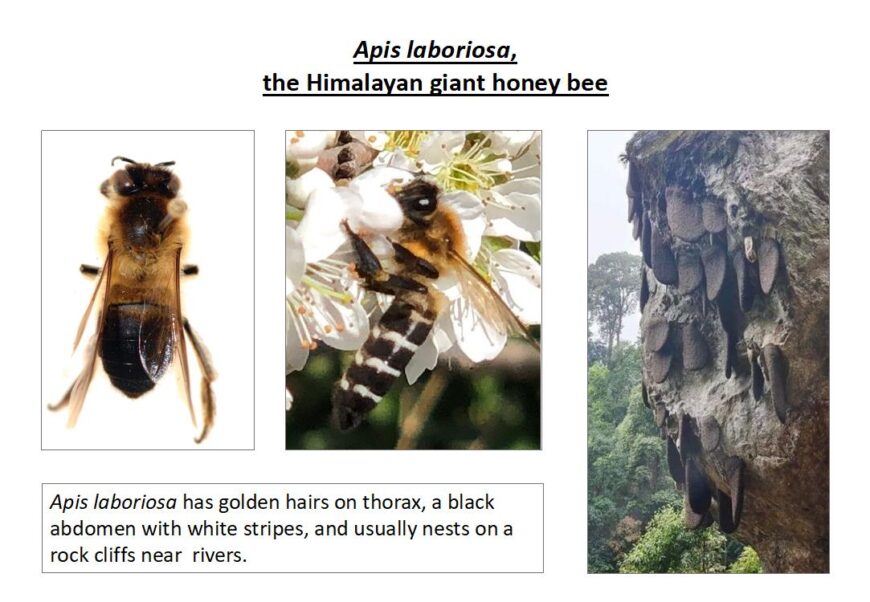
Fig. 4: Show rural residents photographs of the Himalayan Giant Honey bee to help you locate Apis laboriosa colonies. Image source: Gard W. Otis
Places to Search For Honeyguide in Jammu and Kashmir
In J&K, we expect active colonies of bees to occur on overhanging rock cliffs in steep river valleys between April and October, and likely at elevations between 1500 and 3000 m. If you do locate an aggregation of bee colonies, we suggest you wait and watch for the birds to arrive to feed on empty combs and beeswax attached to the rock cliff.
We hope you will be successful in finding the Yellow-rumped Honeyguide and the Himalayan Giant Honey bee in Jammu and Kashmir this year! Photographic evidence of both species would be wonderful. Even if you only discover a cluster of empty bee combs, that will provide the first evidence that the Himalayan Giant Honey bee occurs in Jammu and Kashmir. Moreover, since the Yellow-rumped Honeyguide is most likely a brood parasite, observing adults visiting bird nests or immature individuals receiving food from other bird species will be highly beneficial. Good luck!
We kindly request that you send information about your discoveries to Gard Otis ([email protected]) and Nyaton Kitnya ([email protected]).
The following images from Google maps and Google Earth show some of the river valleys that we anticipate may be inhabited by Giant Honey bees and the Yellow-rumped Honeyguide.
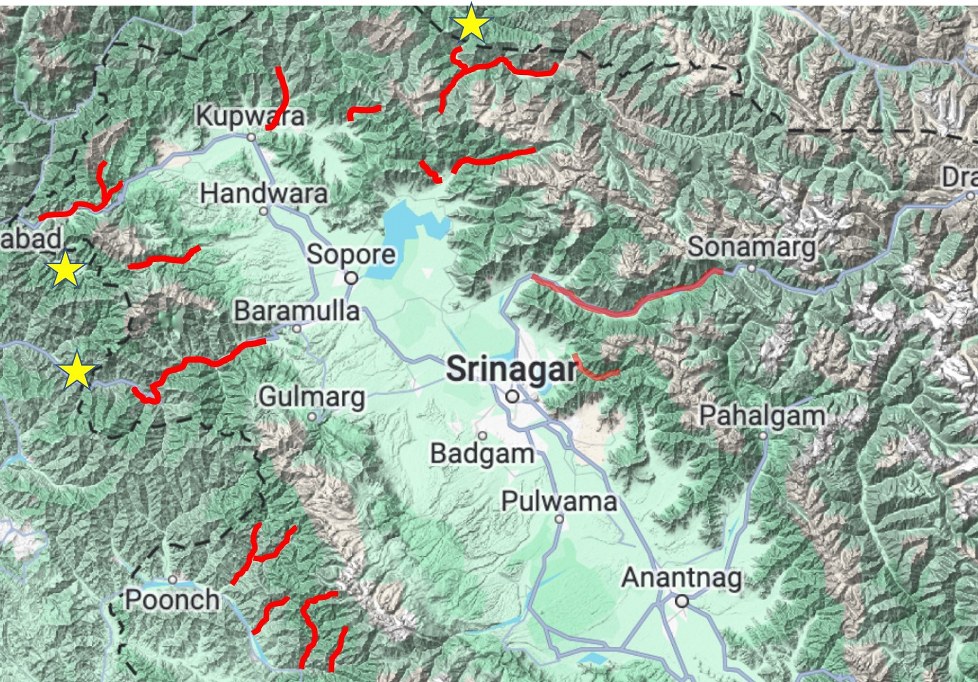
Fig. 5: A Google Map screenshot showing river valleys that lead from the Kashmir Valley into the surrounding mountains, where Apis laboriosa bees and Yellow-rumped Honeyguides are likely to occur. The yellow stars denote the locations where we observed the honeyguides in 2022 and 2023. The dotted line is roughly the location of LoC; access to areas close to it may be a challenge. Image accessed: April 2024.

Fig. 6a: A Google Map screenshot showing Kupwara Valley to search for Apis laboriosa bees and the Yellow-rumped Honeyguide. Image accessed: April 2024.

Fig. 6b, Google Earth image with an aerial view of the mountains and valleys in and around Kupwara. The faint fluorescent line roughly indicates the LoC’s location. Image accessed: April 2024.

Fig. 7: Google Earth satellite view showing the mountains and valleys west of Baramulla. Image accessed: April 2024
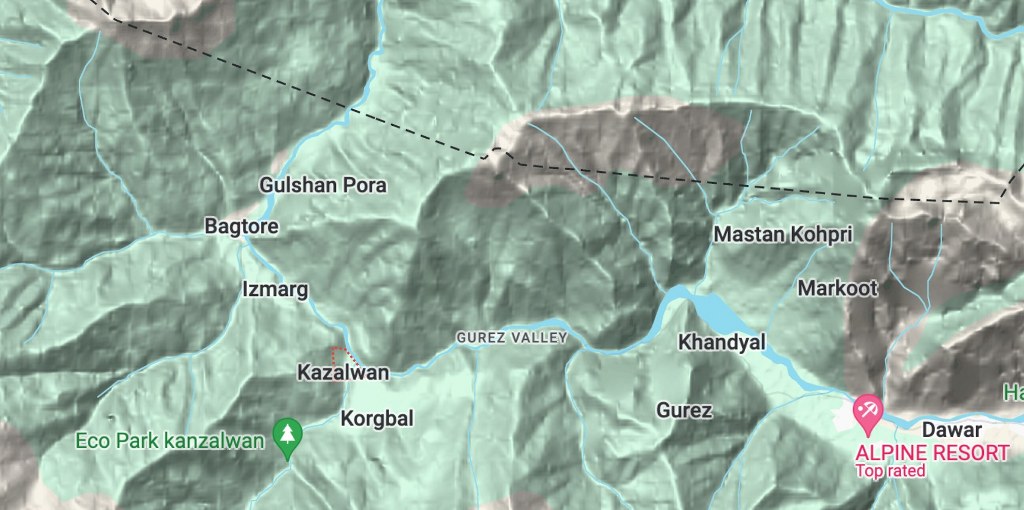
Fig. 8a: Screenshot from Google Maps showing the Gurez Valley. The dotted line is roughly the location of LoC. Image accessed: April 2024.

Fig. 8b: Google Earth satellite view showing the mountains and river valleys in Gurez. Image accessed: April 2024.
Thanks to Alex Berryman for sharing the latest range boundary of the Yellow-rumped Honeyguide.
Find references in this PDF
Header Image: Yellow-rumped Honeyguide Indicator xanthonotus © Su Li/ Macaulay Library


